Credit to Pete Coates / gentleseas
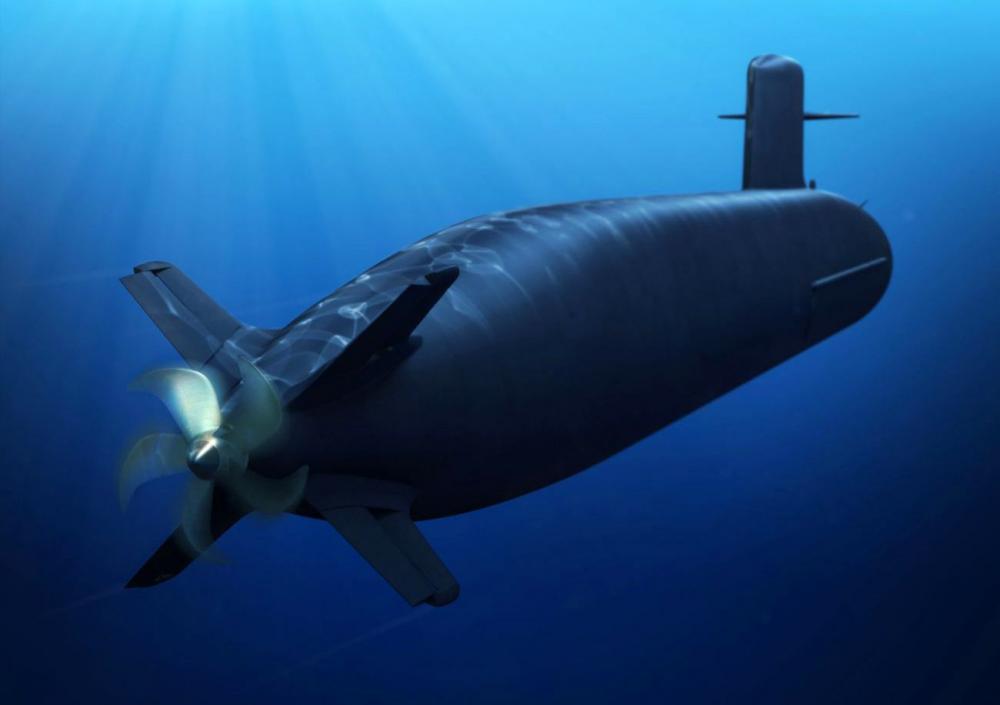
Submarines: DCNS unveils fuel cell AIP
© DCNS
Publié le 07/10/2016 par Vincent Groizeleau
"Given that half the submarines currently on order will be equipped with air-independent propulsion systems, second-generation fuel cells are both a critical technology and an enormous challenge for DCNS.” This was how the guide introduced the machine that a Mer et Marine journalist — the very first — was about to inspect at DCNS’s Indret plant near Nantes. DCNS Indret has long specialised in propulsion systems for the French Navy and international client navies, but, over the last ten years, an Indret-based team has been working in complete secrecy on innovative second-generation fuel cells for submarine AIP systems.
The quest for greater submerged endurance
To date, all diesel-electric submarines have been obliged to surface or snorkel to recharge the batteries that provide power when fully submerged. At such times, submarine are, however, acutely vulnerable to enemy detection.
This explains why leading submarine builders have worked hard, particularly over the last 20 years, to extend the submerged endurance of their conventional-propulsion boats, or SSKs.
From nuclear power to Mesma AIPs
Drawing on nuclear engineering technologies developed for 22 nuclear-powered submarines (ten SSBNs and twelve SSNs) built or under construction for the French Navy, DCNS designed the Mesma AIP with a combustion chamber burning ethanol or fuel oil in the 1990s. Ethanol-type Mesma modules were retrofitted to two DCNS-designed Agosta 90B boats in 2008 and a new-build Agosta 90B in 2011. All three boats are operational with the Pakistan Navy and all three AIPs continue to perform to specification.

Agosta 90B @ DCNS

MESMA module @ DCNS

@ MER ET MARINE
The first AIPs
Submarine builders lacking DCNS’s expertise in nuclear engineering turned to other technologies. Swedish shipbuilder Kockums was the first, with a Stirling-cycle AIP (i.e. one using an external combustion engine) commissioned in 1996. TKMS of Germany followed suit in 2003 with a first-generation fuel cell technology that used hydrogen and oxygen to produce electricity. Like the Stirling-cycle AIP, this worked well with smaller submarines despite its limited power. The TKMS system uses external hydrogen tanks, with obvious weight and size penalties given that the tanks are double-shelled and that 100 tonnes of hydride yields only about 2 tonnes of usable hydrogen. Hydride resupply also demands sophisticated port facilities.
Producing hydrogen on board
To move beyond Mesma and stay ahead of its competitors, DCNS decided to develop the FC‑2G second-generation fuel cell producing onboard hydrogen from standard diesel fuel by chemical re‑formation. In parallel with this effort, the group also developed a patented system to inject nitrogen into the oxygen supply line in the same proportion as in normal air resulting in a mixture that is far less reactive than pure oxygen. This ‘synthetic air’ is then injected into the fuel cells where it reacts with hydrogen to produce electricity.
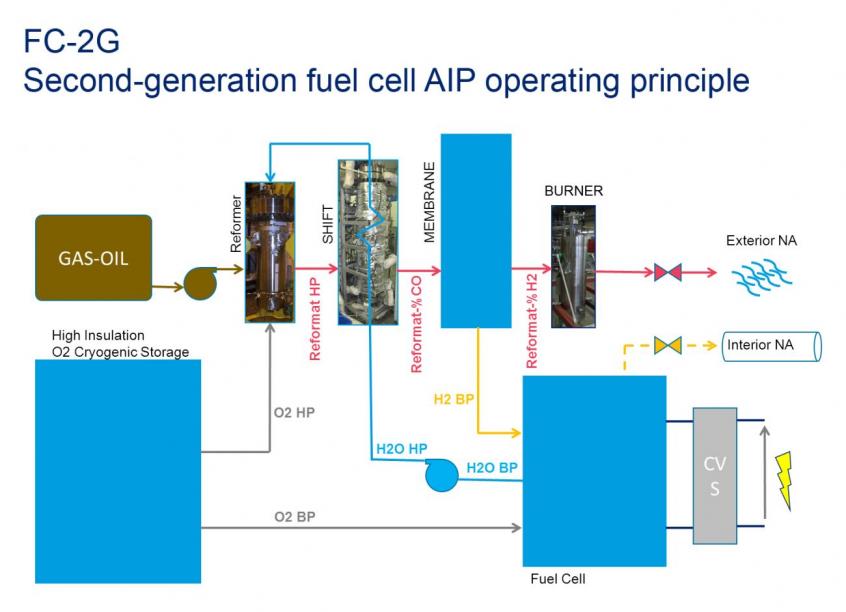
(© : DCNS)
The process can be summarised as follows. Fuel oil is cracked in a reactor operating at high temperature and pressure (several tens of bars). The resulting product then passes through a water gas shift reactor to eliminate the carbon monoxide, then through purification membranes to yield pure hydrogen ready for the fuel cells. The hydrogen is stored in a ventilated enclosed space designed to ensure that any leak can be safely controlled. The process also results in a residual gas that is fed to a catalytic burner to heat the entire system and to preheat the reagents. Despite the fact that the final residual gas is different from that produced by a Mesma AIP, the DCNS team were able to capitalise on aspects of the Mesma system’s downstream portion to quickly dissolve this waste gas in seawater. “The Mesma programme included a major effort to dissolve waste gas close to the hull without compromising the submarine’s acoustic, visual or heat signature. The method developed for the FC‑2G project drew heavily on the Mesma process,” says Marc Quemeneur, AIP engineer and architect.
Oxygen is stored in a large tank as a cryogenic liquid. It is, as already mentioned, mixed with nitrogen then injected into the fuel cell as synthetic air. The reaction between oxygen and hydrogen produces electricity and water. This water is preheated by the fuel cell then fed to the water gas shift and re‑formation reactors before being expelled overboard without comprising the boat’s stealth. The resulting electricity is used both to charge the submarine’s batteries and to power the main propulsion motor.
This technique enables DCNS to use fuel cells developed for commercial applications.
The advantages of fuel oil
Of the fuels considered by DCNS’s AIP engineers, fuel oil offered significant benefits over ethanol and methanol particularly in terms of safety: “methanol vapour is toxic in the event of a leak while ethanol is flammable at temperatures over just 13 to 14°C,” says Xavier Mesnet, a former submariner who today heads up the group’s Marketing and Development team. But this is not fuel oil’s only advantage. Fuel oil is easy to store and is the same as that used by conventional diesel-alternator sets. It is also readily available all over the world, and, “unlike hydrides, which require complex port and handling facilities, fuel oil is easy to store, purchase and transport”.
DCNS’s FC‑2G concept offers significant advantages over fuel cell systems currently in service, and more particularly those using pure oxygen which causes increased wear and requires frequent replacement of filter membranes. The DCNS AIP team believes that the FC‑2G concept is compatible with major maintenance intervals up to five times longer than those of its competitors.

A modular system
Another important advantage of DCNS’s FC‑2G system is its modular design. More specifically, this means that like its predecessor, the system is packaged as a single large hull section, also known as a module or ‘plug’. This 10‑metre-long section can be tailored to any SSK with a hull diameter of at least 6 metres, including, naturally, DCNS’s Scorpene family. Half of the hull section is occupied by the oxygen tank. The FC‑2G module can be integrated with new-build submarines or as part of a major retrofit. The FC‑2G system is equally compatible with both new-generation batteries and conventional lead-acid types. Throughout the FC‑2G development process, DCNS also focussed on new energy storage technologies, including lithium ion batteries, that offer significantly improved performance. Like Mesma, the FC‑2G module includes its own battery compartment which further increases the platform’s submerged endurance.

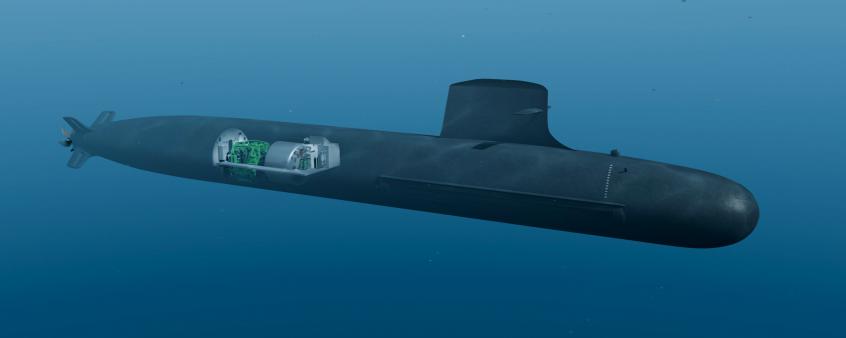
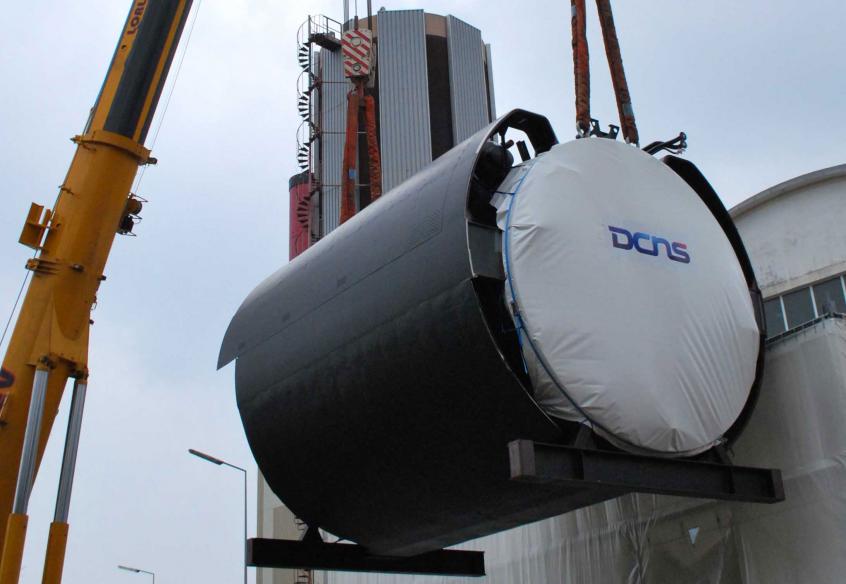
AIP 'plug' (here a Mesma system) ready to integrate with host submarine (© : DCNS)
Greater endurance and tailored to the platform’s lifecycle
A conventional submarine with an FC‑2G AIP can remain submerged and operate at low speed, depending on the mission, for two to three weeks, or five times longer than the same submarine without an AIP. Turning to maintenance, DCNS has designed the system to fit in with the platform’s operating cycles. “Like most SSKs, the FC-2G module’s main components are designed to last 35 to 40 years. Some major subsystems may need to be replaced every 8 to 10 years as part of the boat’s major refits. Minor maintenance requirements also align with the platform’s. The overall aim throughout has been to match the platform’s lifecycle,” says Karl Denecker, the group’s AIP project manager.
Dozens of patents, dozens of new skills
Drawing on in-house expertise and the know-how of French and other partners whose names remain confidential, DCNS worked on this programme in total secrecy until 2014. The development of the FC-2G concept demanded considerable investment in both R&D and testing. “The commitment to the programme was such that, over a period of just four years, the workforce increased from 20 to 100, while the number of patents filed rose from just one a year to over 60. New skills also had to be learnt, one being process engineering. The FC‑2G team now includes engineers specialising in thermochemistry, catalytic reactions and thermal control. Indeed several have doctorates in chemistry.”
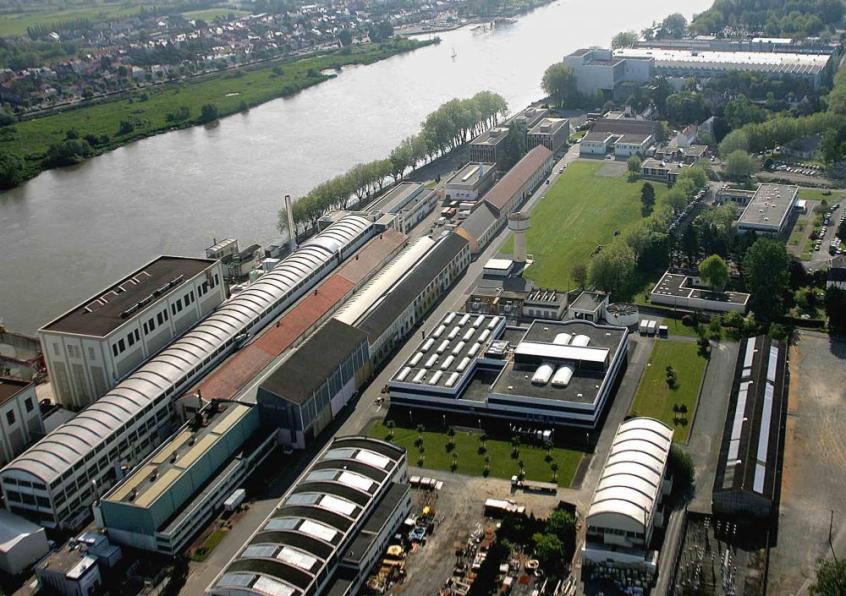
DCNS Indret near Nantes, France (© : DCNS)
Thousands of hours logged
Following preliminary studies that began in 2003, a full-scale system was built at DCNS Indret then tested between 2008 and 2011. Since 2012, this shore system has been used to ruggedise the design and validate performance under simulated operating conditions. “One series of endurance tests simulated a typical submarine patrol and normal operations aboard. To validate the performance of critical components and test the whole system until ready for a scheduled major refit, we put the shore system through three long-duration tests logging thousands of hours while simulating patrols lasting one to two months. The success of these tests means that we are now in a position to warrant operational performance for a Scorpene submarine equipped with the FC‑2G system.”

The shore system (© : DCNS)
System integration and critical processes
DCNS’s FC‑2G shore system is an impressive piece of equipment. It is located close to the large halls at DCNS Indret where the reactors and propulsion motors for French nuclear-powered submarines are assembled and tested. The re‑formation reactor, membrane banks, water gas shift reactor, catalytic burner and fuel cells proper are all there. The complete system, equivalent in height to two submarine decks, is as if ready for integration with a hull section. This technological gem is remarkably compact. System integration and optimisation were among the biggest challenges for DCNS and its partners. “The oxygen was not a big problem. Nor, for that matter, was the hydrogen per se. We’re used to working with hydrogen due its presence in battery compartments. And fuel cells for commercial applications have benefited from tremendous progress. Rather, the big challenges were system integration and certain critical processes, like cracking and filtering, which required a great deal of R&D.”
Automation and safety
To control the shore system, the engineers at DCNS Indret set up a control room similar to a real SSK’s propulsion system control area. Various displays and mimic diagrams present the operators with constantly updated temperatures, pressures, flow rates and the like. During tests, a duty officer and various engineers and technicians stand watch, much as they would during real submarine trials. Like the rest of a modern SSK, the AIP system is highly automated and designed to operate on its own. “The nominal control mode is fully automated. This mode is, however, backed up by an independent safety system that receives data from its own sensors. In the event of a problem, the safety system takes control and may, if necessary, proceed with safe shutdown. It is then up to the watch to find out what caused the problem,” says Marc Quemeneur.
The shore system is heavily instrumented, especially to detect oxygen and hydrogen leaks. This is achieved by constantly monitoring the composition of the air in the system enclosure. “We had to set our own limits. The normal limit for hydrogen in air is 4%. We set our own limit at a much lower value. The thousands of hours logged by the shore system enabled us to correct certain problems and prevent others from occurring. Our tests enabled us to optimise the design and validate its ruggedness by checking the behaviour and wear of key components over time. They also helped us to specify the safety systems. After all, the aim is not only to develop a system that is reliable and efficient, but also to ensure maximum safety.”

New Scorpene submarine (© : DCNS)
Ready to go into production
DCNS’s AIP engineers stress that the FC‑2G system has no impact on the submarine’s overall performance and in particular none whatsoever on its dive performance or acoustic discretion. The construction and successful operation of a full-scale shore system at the Indret plant, and the fact that it has logged thousands of hours, mean that the group is now ready to proceed with production.
“Given their impact on SSK operations and the interest many countries have shown in their procurement, AIP technologies represent an enormous challenge for submarine builders. Hence DCNS’s commitment to offer submarines equipped with AIP systems that are reliable, efficient and meet the operational needs of client navies. The FC‑2G is that system. This ambitious project has been the focus of a major R&D effort for some ten years. As such, it represents one of our top priorities in terms of technology, industrial partnerships and expertise,” concludes Xavier Mesnet.
Written by Vincent Groizeleau, translated by Steve Dys

Submarines: DCNS unveils fuel cell AIP
© DCNS
Publié le 07/10/2016 par Vincent Groizeleau
"Given that half the submarines currently on order will be equipped with air-independent propulsion systems, second-generation fuel cells are both a critical technology and an enormous challenge for DCNS.” This was how the guide introduced the machine that a Mer et Marine journalist — the very first — was about to inspect at DCNS’s Indret plant near Nantes. DCNS Indret has long specialised in propulsion systems for the French Navy and international client navies, but, over the last ten years, an Indret-based team has been working in complete secrecy on innovative second-generation fuel cells for submarine AIP systems.
The quest for greater submerged endurance
To date, all diesel-electric submarines have been obliged to surface or snorkel to recharge the batteries that provide power when fully submerged. At such times, submarine are, however, acutely vulnerable to enemy detection.
This explains why leading submarine builders have worked hard, particularly over the last 20 years, to extend the submerged endurance of their conventional-propulsion boats, or SSKs.
From nuclear power to Mesma AIPs
Drawing on nuclear engineering technologies developed for 22 nuclear-powered submarines (ten SSBNs and twelve SSNs) built or under construction for the French Navy, DCNS designed the Mesma AIP with a combustion chamber burning ethanol or fuel oil in the 1990s. Ethanol-type Mesma modules were retrofitted to two DCNS-designed Agosta 90B boats in 2008 and a new-build Agosta 90B in 2011. All three boats are operational with the Pakistan Navy and all three AIPs continue to perform to specification.

Agosta 90B @ DCNS

MESMA module @ DCNS

@ MER ET MARINE
The first AIPs
Submarine builders lacking DCNS’s expertise in nuclear engineering turned to other technologies. Swedish shipbuilder Kockums was the first, with a Stirling-cycle AIP (i.e. one using an external combustion engine) commissioned in 1996. TKMS of Germany followed suit in 2003 with a first-generation fuel cell technology that used hydrogen and oxygen to produce electricity. Like the Stirling-cycle AIP, this worked well with smaller submarines despite its limited power. The TKMS system uses external hydrogen tanks, with obvious weight and size penalties given that the tanks are double-shelled and that 100 tonnes of hydride yields only about 2 tonnes of usable hydrogen. Hydride resupply also demands sophisticated port facilities.
Producing hydrogen on board
To move beyond Mesma and stay ahead of its competitors, DCNS decided to develop the FC‑2G second-generation fuel cell producing onboard hydrogen from standard diesel fuel by chemical re‑formation. In parallel with this effort, the group also developed a patented system to inject nitrogen into the oxygen supply line in the same proportion as in normal air resulting in a mixture that is far less reactive than pure oxygen. This ‘synthetic air’ is then injected into the fuel cells where it reacts with hydrogen to produce electricity.

(© : DCNS)
The process can be summarised as follows. Fuel oil is cracked in a reactor operating at high temperature and pressure (several tens of bars). The resulting product then passes through a water gas shift reactor to eliminate the carbon monoxide, then through purification membranes to yield pure hydrogen ready for the fuel cells. The hydrogen is stored in a ventilated enclosed space designed to ensure that any leak can be safely controlled. The process also results in a residual gas that is fed to a catalytic burner to heat the entire system and to preheat the reagents. Despite the fact that the final residual gas is different from that produced by a Mesma AIP, the DCNS team were able to capitalise on aspects of the Mesma system’s downstream portion to quickly dissolve this waste gas in seawater. “The Mesma programme included a major effort to dissolve waste gas close to the hull without compromising the submarine’s acoustic, visual or heat signature. The method developed for the FC‑2G project drew heavily on the Mesma process,” says Marc Quemeneur, AIP engineer and architect.
Oxygen is stored in a large tank as a cryogenic liquid. It is, as already mentioned, mixed with nitrogen then injected into the fuel cell as synthetic air. The reaction between oxygen and hydrogen produces electricity and water. This water is preheated by the fuel cell then fed to the water gas shift and re‑formation reactors before being expelled overboard without comprising the boat’s stealth. The resulting electricity is used both to charge the submarine’s batteries and to power the main propulsion motor.
This technique enables DCNS to use fuel cells developed for commercial applications.
The advantages of fuel oil
Of the fuels considered by DCNS’s AIP engineers, fuel oil offered significant benefits over ethanol and methanol particularly in terms of safety: “methanol vapour is toxic in the event of a leak while ethanol is flammable at temperatures over just 13 to 14°C,” says Xavier Mesnet, a former submariner who today heads up the group’s Marketing and Development team. But this is not fuel oil’s only advantage. Fuel oil is easy to store and is the same as that used by conventional diesel-alternator sets. It is also readily available all over the world, and, “unlike hydrides, which require complex port and handling facilities, fuel oil is easy to store, purchase and transport”.
DCNS’s FC‑2G concept offers significant advantages over fuel cell systems currently in service, and more particularly those using pure oxygen which causes increased wear and requires frequent replacement of filter membranes. The DCNS AIP team believes that the FC‑2G concept is compatible with major maintenance intervals up to five times longer than those of its competitors.

A modular system
Another important advantage of DCNS’s FC‑2G system is its modular design. More specifically, this means that like its predecessor, the system is packaged as a single large hull section, also known as a module or ‘plug’. This 10‑metre-long section can be tailored to any SSK with a hull diameter of at least 6 metres, including, naturally, DCNS’s Scorpene family. Half of the hull section is occupied by the oxygen tank. The FC‑2G module can be integrated with new-build submarines or as part of a major retrofit. The FC‑2G system is equally compatible with both new-generation batteries and conventional lead-acid types. Throughout the FC‑2G development process, DCNS also focussed on new energy storage technologies, including lithium ion batteries, that offer significantly improved performance. Like Mesma, the FC‑2G module includes its own battery compartment which further increases the platform’s submerged endurance.



AIP 'plug' (here a Mesma system) ready to integrate with host submarine (© : DCNS)
Greater endurance and tailored to the platform’s lifecycle
A conventional submarine with an FC‑2G AIP can remain submerged and operate at low speed, depending on the mission, for two to three weeks, or five times longer than the same submarine without an AIP. Turning to maintenance, DCNS has designed the system to fit in with the platform’s operating cycles. “Like most SSKs, the FC-2G module’s main components are designed to last 35 to 40 years. Some major subsystems may need to be replaced every 8 to 10 years as part of the boat’s major refits. Minor maintenance requirements also align with the platform’s. The overall aim throughout has been to match the platform’s lifecycle,” says Karl Denecker, the group’s AIP project manager.
Dozens of patents, dozens of new skills
Drawing on in-house expertise and the know-how of French and other partners whose names remain confidential, DCNS worked on this programme in total secrecy until 2014. The development of the FC-2G concept demanded considerable investment in both R&D and testing. “The commitment to the programme was such that, over a period of just four years, the workforce increased from 20 to 100, while the number of patents filed rose from just one a year to over 60. New skills also had to be learnt, one being process engineering. The FC‑2G team now includes engineers specialising in thermochemistry, catalytic reactions and thermal control. Indeed several have doctorates in chemistry.”

DCNS Indret near Nantes, France (© : DCNS)
Thousands of hours logged
Following preliminary studies that began in 2003, a full-scale system was built at DCNS Indret then tested between 2008 and 2011. Since 2012, this shore system has been used to ruggedise the design and validate performance under simulated operating conditions. “One series of endurance tests simulated a typical submarine patrol and normal operations aboard. To validate the performance of critical components and test the whole system until ready for a scheduled major refit, we put the shore system through three long-duration tests logging thousands of hours while simulating patrols lasting one to two months. The success of these tests means that we are now in a position to warrant operational performance for a Scorpene submarine equipped with the FC‑2G system.”

The shore system (© : DCNS)
System integration and critical processes
DCNS’s FC‑2G shore system is an impressive piece of equipment. It is located close to the large halls at DCNS Indret where the reactors and propulsion motors for French nuclear-powered submarines are assembled and tested. The re‑formation reactor, membrane banks, water gas shift reactor, catalytic burner and fuel cells proper are all there. The complete system, equivalent in height to two submarine decks, is as if ready for integration with a hull section. This technological gem is remarkably compact. System integration and optimisation were among the biggest challenges for DCNS and its partners. “The oxygen was not a big problem. Nor, for that matter, was the hydrogen per se. We’re used to working with hydrogen due its presence in battery compartments. And fuel cells for commercial applications have benefited from tremendous progress. Rather, the big challenges were system integration and certain critical processes, like cracking and filtering, which required a great deal of R&D.”
Automation and safety
To control the shore system, the engineers at DCNS Indret set up a control room similar to a real SSK’s propulsion system control area. Various displays and mimic diagrams present the operators with constantly updated temperatures, pressures, flow rates and the like. During tests, a duty officer and various engineers and technicians stand watch, much as they would during real submarine trials. Like the rest of a modern SSK, the AIP system is highly automated and designed to operate on its own. “The nominal control mode is fully automated. This mode is, however, backed up by an independent safety system that receives data from its own sensors. In the event of a problem, the safety system takes control and may, if necessary, proceed with safe shutdown. It is then up to the watch to find out what caused the problem,” says Marc Quemeneur.
The shore system is heavily instrumented, especially to detect oxygen and hydrogen leaks. This is achieved by constantly monitoring the composition of the air in the system enclosure. “We had to set our own limits. The normal limit for hydrogen in air is 4%. We set our own limit at a much lower value. The thousands of hours logged by the shore system enabled us to correct certain problems and prevent others from occurring. Our tests enabled us to optimise the design and validate its ruggedness by checking the behaviour and wear of key components over time. They also helped us to specify the safety systems. After all, the aim is not only to develop a system that is reliable and efficient, but also to ensure maximum safety.”

New Scorpene submarine (© : DCNS)
Ready to go into production
DCNS’s AIP engineers stress that the FC‑2G system has no impact on the submarine’s overall performance and in particular none whatsoever on its dive performance or acoustic discretion. The construction and successful operation of a full-scale shore system at the Indret plant, and the fact that it has logged thousands of hours, mean that the group is now ready to proceed with production.
“Given their impact on SSK operations and the interest many countries have shown in their procurement, AIP technologies represent an enormous challenge for submarine builders. Hence DCNS’s commitment to offer submarines equipped with AIP systems that are reliable, efficient and meet the operational needs of client navies. The FC‑2G is that system. This ambitious project has been the focus of a major R&D effort for some ten years. As such, it represents one of our top priorities in terms of technology, industrial partnerships and expertise,” concludes Xavier Mesnet.
Written by Vincent Groizeleau, translated by Steve Dys


